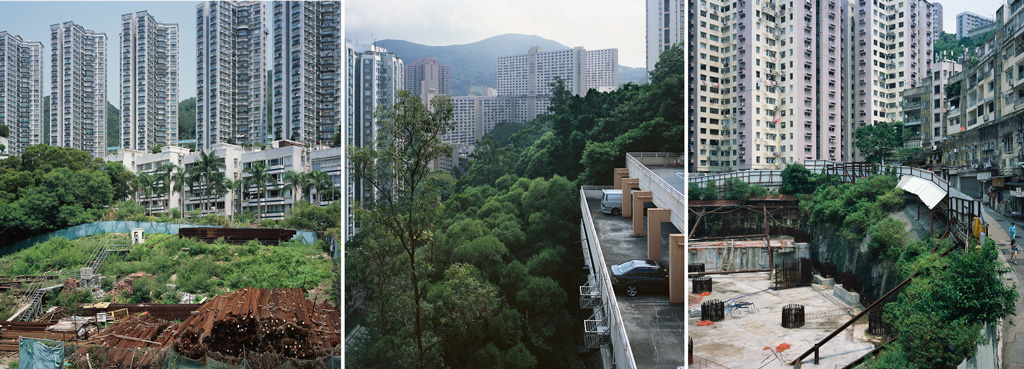
Chan Hong Yui Clement
Opens Wednesday 16 May, 6 – 8pm
Runs 17 – 27 May 2018
Part of the Head On Photo Festival
Read a Review by Connor Pearce, in Backyard Opera Magazine here
Hong Kong-based artist Chan Hong Yui Clement works primarily with photographic images. Through his diverse approach to image-making, Chan reveals both the limitations and potentials inherent in the photographic language, resulting in image-based works that tend to be medium-specific and process-driven.
Hong Kong is situated on a hilly and mountainous terrain. Because of the lack of natural flat land, Hong Kong simply does not have the prerequisite to be designed into a grid system—a town planning method that is found in many other world cities such as New York. According to the Hong Kong Planning Department, about 47% of the land in Hong Kong lies above 100 mPD (metres above Principal Datum, i.e. 1.23m below the mean sea level in Hong Kong). Almost half of Hong Kong therefore has to be built on uplands, resulting in what is commonly known as a multi-level urban design.
Z-Axis aims at documenting the type of multi-level urban design that is shaped by the hilly and mountainous terrain in Hong Kong. Z-Axis, in mathematical terms, refers to the depth of an object in a three-dimensional coordinate system. Looking into the Hong Kong urban landscape along the Z-Axis, one can gain more understanding of how the topographical factor impacts Hong Kong people’s habitation and to what extent the land has been altered in an attempt to adapt to the natural environment.
Human-axis
By Scott Dietrich | May 2018
Figure-ground relationships dominate the landscape of Clement Chan’s photographs. The relationship of the figure or human to the lack of an easily recognized ground or horizon is a defining feature of Hong Kong’s built environment. The ground in Chan’s work is not only an aesthetic device that helps the viewer differentiate foreground from the background but it also refers literally to the ground on which Hong Kong is built. This is revealed in the exploration of what Chan calls the z-axis. Throwing off the more traditional approach to architectural photography, which most often looks at facades and volumes in relation to the horizon, Chan places the three-dimensional gesture of structural engineering in relation to the ever-changing ground of Hong Kong into the center his photographs.
Portico Journal’s article “Architectural Drawings | The Figure Ground” provides definitions of the figure-ground relationship as a means of visual representation in both architecture and art. “In architecture, figure-ground drawings are useful for showing how the material or solid components of buildings relate to the spaces contained by the built form.”[1] In Chan’s photographs, it is not the spaces contained within the building that are defined by this relationship but the spaces created from the landscape that is defined by the buildings. The monumental architecture of Hong Kong, born out of a necessity for housing and a vertical landscape, appears to encapsulate the land that it is built on. The solid components of the building are seen in Chan’s images as a way to define the ground, a relationship that is the inverse of many architectural forms.
This is further explored when Chan’s images are situated in the practice of art. Again, Portico offers a definition, “In art practice, a figure-ground drawing focuses on the visual relationship between foreground and background. Artists play with these relations, investigating questions such as: How do viewers perceive a difference? How do edges affect the images we see? How do we make sense of the spaces in a drawing?”[2] How do we make sense of the monumentality of Hong Kong’s built environment? Chan does so by seeking out architectural subjects that are endemic in Hong Kong. Features such as parking decks hung off the sides of mountains; foundations exposed and unashamed rising above their usual earthly enclosures; externalized infrastructure hung like ornament forming the function of the city; ultimately we see the pedestrian walkways which deliver the human/figure from one destination to another while keeping the human figure unmoored from the ground.
These practical engineering works are the evidence of a city with little regard for the traditional sense of human scale and figure-ground relationships. The ways in which the citizens of Hong Kong have adapted and created a built environment on a less than ideal landscape may be one of the city’s most creative accomplishments. One can see the architectural gymnastics being done on the part of the engineers that are asked to solve Hong Kong’s most daunting creative problem, that of its unruly ground. How do you make sense of a city built under such adverse circumstances, Chan’s images would argue, by looking at the z-axis
[1] “Architectural Drawings | The Figure Ground.” PORTICO, portico.space/journal//architectural-drawings-the-figure-ground.
[2] Ibid.
About Scott Dietrich
Scott Dietrich received a B.F.A. from the University of Arizona in 1994 and an M.F.A. from the School of the Art Institute of Chicago in 1996. He has worked in the higher education, gallery, museum, and commercial fields of photography for the past 20 years. His photographic and image making practice is a reaction to the built environment and the creative efforts of inspired artists, builders and crafts people that he encounters during extensive travels throughout Southeast Asia, China and the United States. He works as an independent curator and scholar, educator, artist and photographer.
Recently he was co-curator of exhibitions for the Hong Kong Stair Archive project which was the culmination of a two year research and photographic documentation process dealing with the unique vertical urban environment of Hong Kong’s Central and Western districts. Currently he is a Sargent Fellow at the Arnold Arboretum of Harvard University where he is utilizing the Universities holdings of early 20th century photographic archives of China, Japan and Southeast Asia to develop new works and generate publications.
www.itinerantphoto.com
scott@itinerantphoto.com
